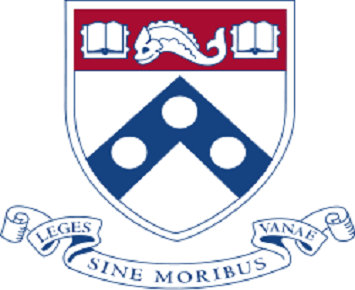Live in USA
 |
The University of Pennsylvania (commonly referred to as Penn or UPenn) is an
American private Ivy League research university located in Philadelphia,
Pennsylvania, United States. Incorporated as The Trustees of the University of
Pennsylvania, Penn is one of 14 founding members of the Association of American
Universities and one of the nine original Colonial Colleges.
Benjamin
Franklin, Penn's founder, advocated an educational program that focused as much
on practical education for commerce and public service as on the classics and
theology. Penn was one of the first academic institutions to follow a
multidisciplinary model pioneered by several European universities,
concentrating multiple "faculties" (e.g., theology, classics, medicine) into one
institution.6 It was also home to many other educational innovations. The first
school of medicine in North America (Perelman School of Medicine, 1765), the
first collegiate business school (Wharton, 1881) and the first student union
(Houston Hall, 1896)7 were all born at Penn.
Penn offers a broad range of
academic departments, an extensive research enterprise and a number of community
outreach and public service programs. It is particularly well known for its
medical school, dental school, design school, school of business, law school,
communications school, nursing school, veterinary school, its social sciences
and humanities programs, as well as its biomedical teaching and research
capabilities. Its undergraduate programs are also among the most selective in
the country (9.9% acceptance rate).8 One of Penn's most well known academic
qualities is its emphasis on interdisciplinary education, which it promotes
through numerous joint degree programs, research centers and professorships, a
unified campus, and the ability for students to take classes from any of Penn's
schools (the "One University Policy").9
All of Penn's schools exhibit very
high research activity. Penn is consistently included among the top five
research universities in the United States,10 and among the top research
universities in the world, for both quality and quantity of research.11 In
fiscal year 2011, Penn topped the Ivy League in academic research spending with
an $814 million budget, involving some 4,000 faculty, 1,100 postdoctoral fellows
and 5,400 support staff/graduate assistants.2 As one of the most active and
prolific research institutions, Penn is associated with several important
innovations and discoveries in many fields of science and the humanities. Among
them are the first general purpose electronic computer (ENIAC), the Rubella and
Hepatitis B vaccines, Retin-A, cognitive therapy, conjoint analysis and others.
Penn's academic and research programs are led by a large and highly productive
faculty.12 Nine Penn faculty members or graduates have won a Nobel Prize in the
last ten years. Over its long history the university has also produced many
distinguished alumni. These include twelve heads of state (including one U.S.
President), three United States Supreme Court justices, and supreme court
justices of other states, founders of technology companies, international law
firms, and global financial institutions, university presidents and eighteen
living billionaires.
In 1740, a group of Philadelphians joined together to
erect a great preaching hall for the traveling evangelist George Whitefield, who
toured the American colonies delivering open air sermons. The building was
designed and built by Edmund Woolley and was the largest building in the city at
the time. It was initially planned to serve as a charity school as well;
however, a lack of funds forced plans for the chapel and school to be suspended.
In the fall of 1749, eager to create a school to educate future generations,
Benjamin Franklin circulated a pamphlet titled "Proposals for the Education of
Youth in Pennsylvania," his vision for what he called a "Public Academy of
Philadelphia."15 However, according to Franklin's autobiography, it was in 1743
when he first had the idea to establish an academy, "thinking the Rev. Richard
Peters a fit person to superintend such an institution." Unlike the other
Colonial colleges that existed in 1743¡ªHarvard, William and Mary, and
Yale¡ªFranklin's new school would not focus merely on education for the clergy.
He advocated an innovative concept of higher education, one which would teach
both the ornamental knowledge of the arts and the practical skills necessary for
making a living and doing public service. The proposed program of study could
have become the nation's first modern liberal arts curriculum, although it was
never implemented because William Smith, an Anglican priest who was provost at
the time, and other trustees preferred the traditional curriculum.1617
Franklin assembled a board of trustees from among the leading citizens of
Philadelphia, the first such non-sectarian board in America. At the first
meeting of the 24 members of the Board of Trustees (November 13, 1749) the issue
of where to locate the school was a prime concern. Although a lot across Sixth
Street from Independence Hall was offered without cost by James Logan, its
owner, the Trustees realized that the building erected in 1740, which was still
vacant, would be an even better site. The original sponsors of the dormant
building still owed considerable construction debts and asked Franklin's group
to assume their debts and, accordingly, their inactive trusts. On February 1,
1750 the new board took over the building and trusts of the old board. On August
13, 1751 the Academy of Philadelphia, using the great hall at 4th and Arch
Streets, took in its first secondary students. A charity school also was opened
in accordance with the intentions of the original "New Building" donors,
although it lasted only a few years. In 1755, the College of Philadelphia was
chartered, paving the way for the addition of undergraduate instruction. All
three schools shared the same Board of Trustees and were considered to be part
of the same institution.
Download